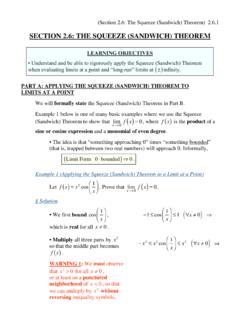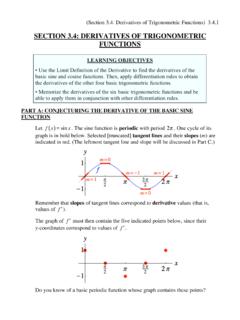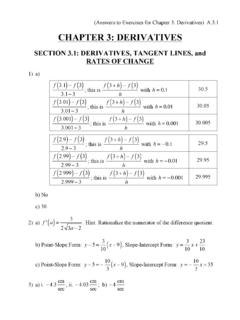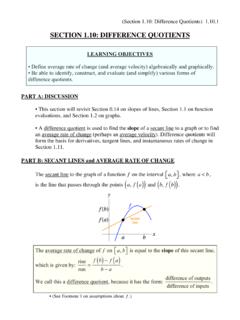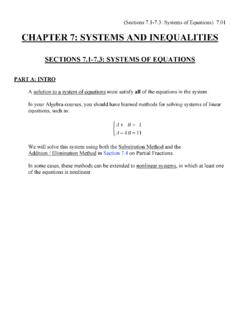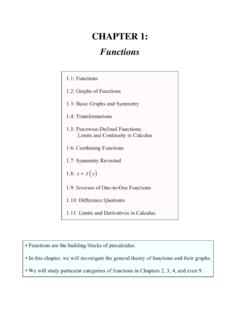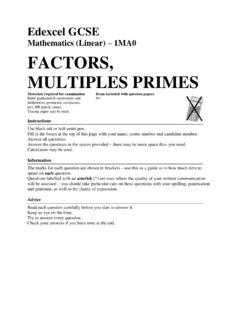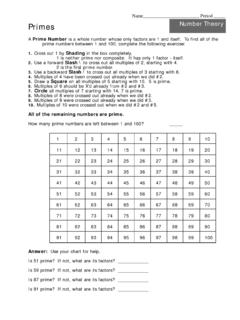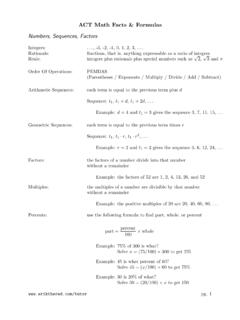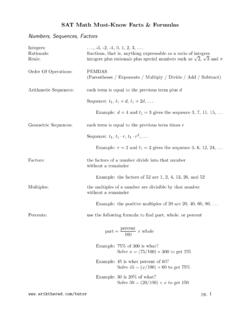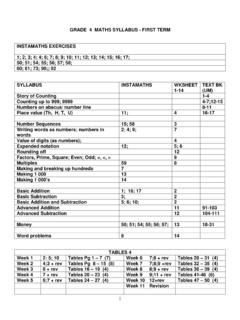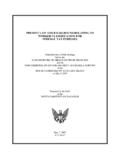Transcription of SECTION 2.5: FINDING ZEROS OF POLYNOMIAL …
1 SECTION : FINDING ZEROS OF POLYNOMIAL FUNCTIONS Assume fx() is a nonconstant POLYNOMIAL with real coefficients written in standard form. PART A: TECHNIQUES WE HAVE ALREADY SEEN Refer to: Notes to SECTION in the book Notes Refer to 1) Factoring (Notes ) 2) Methods for Dealing with Quadratic Functions (Book SECTION : ) a) Square Root Method (Notes , ) b) Factoring (Notes ) c) QF (Notes , ) d) CTS (Completing the Square) (Book SECTION .
2 3) Bisection Method (for Approximating ZEROS ) (Notes to ) 4) Synthetic Division and the Remainder Theorem (for Verifying ZEROS ) (Notes ) PART B: RATIONAL zero TEST Rational zero Test (or Rational Roots Theorem) Let fx() be a POLYNOMIAL with integer ( , only integer) coefficients written in standard form: anxn+an 1xn 1+..+a1x+a0 each constant ai Z;an 0;a0 0;n Z+() If fx() has rational ZEROS , they must be in the list of pq candidates, where: p is a factor of a0, the constant term, and q is a factor of an, the leading coefficient.
3 Note: We require a0 0. If a0=0, try factoring out the GCF first. Example Factor fx()=4x3 5x2 7x+2 completely, and find all of its real ZEROS . Solution Since the GCF=1, and Factoring by Grouping does not seem to help, we resort to using the Rational zero Test. We will now list the candidates for possible rational ZEROS of fx(). p (factors of the constant term, 2): 1, 2 q (factors of the leading coefficient, 4): 1, 2, 4 Note: You may omit the symbols above if you use them below. List of pq candidates: 11, 12, 14, 21, 22, 24 Simplified: 1, 12, 14, 2, 1, 12 Redundant Use Synthetic Division to divide fx() by x k(), where k is one of our rational candidates.
4 Remember that the following are equivalent for a nonzero POLYNOMIAL fx() and a real number k: x k() is a factor of fx() k is a zero of fx() , fk()=0() We get a 0 remainder in the Synthetic Division process. The first is the Factor Theorem, and the second comes from the Remainder Theorem. See Notes on SECTION : We use trial-and-error and proceed through our list of candidates (k) for rational ZEROS : 1, 12, 14, 2 Let s try k=1. Method 1 We may directly evaluate f1() and see if it is 0. fx()=4x3 5x2 7x+2f1()=41()3 51()2 71()+2= 6 0() Therefore, 1 is not a zero of fx().
5 Method 2 We may also use the Synthetic Division process and see if we get a 0 remainder. We do not get a 0 remainder, so 1 is not a zero of fx(). Method 3 Observe from both previous methods that we can compute f1() by simply adding up the coefficients of fx() in standard form. This does not work in general for other values of k, though. Let s try k=2. Let s use the Synthetic Division / Remainder Theorem method: We do get a 0 remainder, so 2 is a zero of fx(). This turns out to be the key that cracks the whole problem.
6 Incidentally, this is the same fx() that we saw in Notes Now we know how our little bird got its info! By the Factor Theorem, x 2() must be a factor of fx(). We can find qx(), the other (quadratic) factor, by using the last row of the table. fx()=x 2() 4x2+3x 1() Factor qx() completely over the reals: fx()=x-2()4x-1()x+1() Remember that we always know how to break down a quadratic (use the QF if you have to), although its ZEROS may or may not be real. We no longer have to rely on rational ZEROS at this point.
7 The ZEROS of fx() are the ZEROS of these factors: 2, 14, -1 Observe that all three are rational and appeared in our list of candidates for rational ZEROS . Any one of these three could have been used to start cracking the problem. Below is a graph of fx()=4x3 5x2 7x+2. Where are the x-intercepts? Note: If we can get a graph of fx() beforehand, then we may be able to choose our guesses for rational ZEROS more wisely. Warning: Remember that the template for our list of candidates is: factor of constant termfactor of leading coefficient, not the reciprocal.
8 One way to remember which way the template goes is to use a simple example such as x 2. The list must be 1, 2 and not 1, 12. Note: If none of our rational candidates work, then fx() has no rational ZEROS . For example, x2 3 has no rational ZEROS . Note: Synthetic Division may be applied repeatedly. It may be a good idea to revise the list of rational candidates before each new application (the textbook does not do this). A candidate that worked as a zero before may work again (in which case it is a repeated zero ), but a candidate that failed before will never work.
9 You may want to stop using Synthetic Division when you get down to a quadratic, or when you get down to something you think you can factor, such as x4 1. Note: Synthetic Division may be used when we are dealing with imaginary ZEROS and imaginary coefficients. This is reflected in the students Study and Solutions Guide. PART C: FACTORING OVER VARIOUS SETS Recall our Venn diagram from Notes : Factoring over Z (the Integers) Example In our Example in Part B, we factored: 4x3 5x2 7x+2=x-2()4x-1()x+1() This is an example of factoring over Z, because we only use integers as coefficients (including constant terms within factors).
10 Factoring over Q (the Rationals) Example Let s factor a 4 out of the second factor in the previous Example. 4x3 5x2 7x+2=x-2()4x-1()x+1() Factored over Z=4x-2()x-14 x+1() Factored over Q The Factored over Z expression is also an example of factoring over Q, but this new factorization over Q immediately identifies 14 as a zero . Factoring over R (the Reals) Example x2 3 is prime (or irreducible) over Z and Q; it cannot be factored further (nontrivially; breaking out a 1 or a 1 doesn t count) using only integer or rational coefficients.


